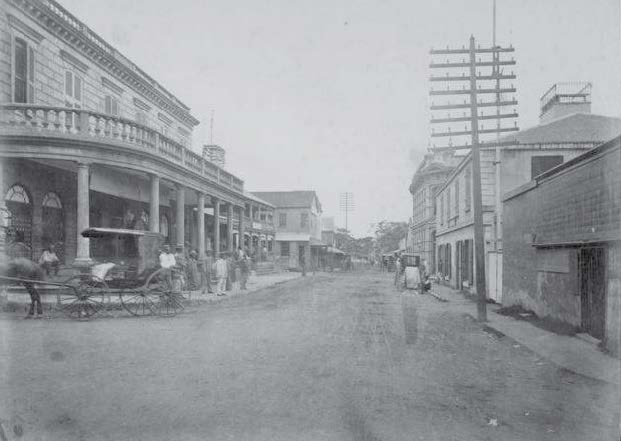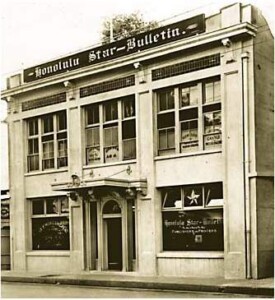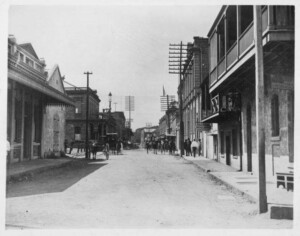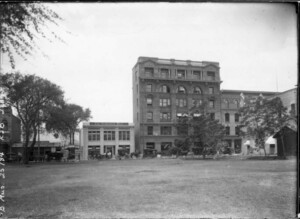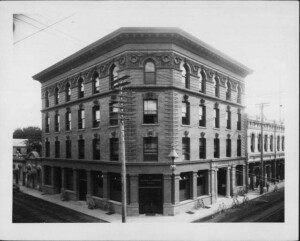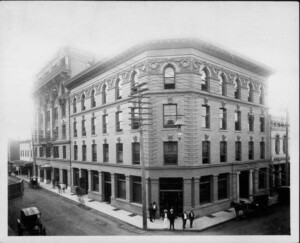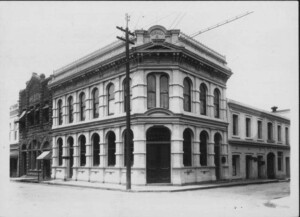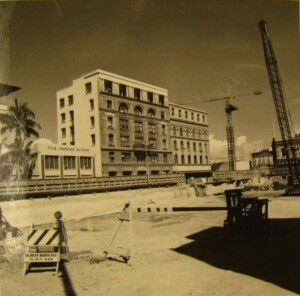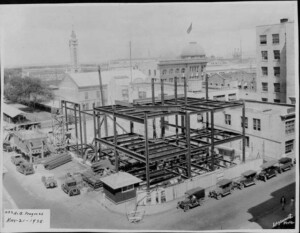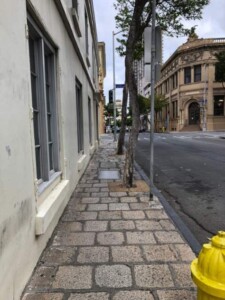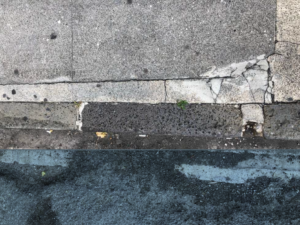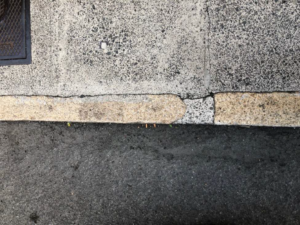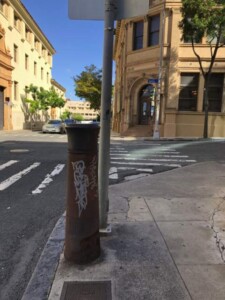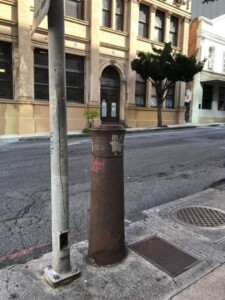The Merchant Street Commercial and Civic Historic District located in downtown Honolulu is an excellent example of an early commercial center in post-contact, pre-territorial, and Territorial Hawai‘i. As one of the first official streets in Hawai‘i and one of the city’s first economic hubs, it is significant for its role as ‘Honolulu’s Wall Street’, the location of the Honolulu Stock Exchange, banks, insurance companies, sugar factors, and commission agents. Four out of the five members of the ‘Big Five’ maintained their offices in buildings included within the District. The District retains a notable concentration of intact, historic, commercial, and municipal buildings from the mid-19th to mid-20th centuries.
In November 2021 the Hawai‘i Historic Places Review Board approved an update and amendment to the Merchant Street Commercial and Civic Historic District listing on the Hawai‘i State Register of Historic Places. The original nomination was approved in 1973. (Download the nomination forms.)
This amended form provides much needed clarification, along with expanded description and significance sections, details the district’s history as well as its architectural character, and has added two buildings to the district (The Honolulu Star-Bulletin Building and the Alexander & Baldwin Building). Other new resources added to this district nomination are the site of the original Honolulu Hale and four objects: granite curbs and sidewalks, lava rock curbs, cannons, and a remnant of a cast-iron storefront. (See detailed descriptions below.)
Click below to download a poster with a map of the district sites (the original sites and those added to the amended nomination in 2021 are delineated).
A Walk Though Historical Merchant Street
Historical images of several of the iconic buildings of Merchant Street Historic District photographed between 1879 and 1966 .
- Honolulu Star-Bulletin Building in 1916. Image courtesy of the Honolulu Star-Bulletin.
- Ca. 1892 photo taken at intersection of Merchant Street and Nu’uanu Avenue facing south-southeast. A section of the Royal Saloon is visible in the left foreground after which is the original façade of the J. T. Waterhouse Building. The Kamehameha V Post Office is visible in the left midground. Buildings in the right foreground were demolished for the construction of the Old Honolulu Police Station. The Melchers Building and the Bishop Bank Building are somewhat discernible in the left mid- and background. Photo by Jerome Baker. Courtesy of the HawaiiState Archives, PP-38-7-040.
- Ca. 1911 photo taken on Merchant Street near Bethel Street facing south-southeastwith a section of the Yokohama Specie Bank in the left foreground and the Kamehameha V Post Office Building in the left background. Buildings in the right foreground were demolished to build the Old Honolulu Police Station (1931). The Judd Block and Stangenwald Building are visible in the distance. Image courtesy of the Hawaii State Archives, PP-38-8-008.
- Photo of Stangenwald Building (center) with Honolulu Star-Bulletin Building (left) and portion of Judd Block (right) Photo by Ray Jerome Baker, ca. 1912. Courtesy of the Hawaii State Archives, PP-38-8-005.
- Judd Building before construction of Stangenwald Building next door. Image courtesy of the Hawaii State Archives, PP-6-3-017
- Undated photo of the Judd Block (right) and Stangenwald Building (left). Image courtesy of the Hawaii State Archives, PP-6-3-015.
- Bishop Bank Building in foreground with Bishop Estate Building in background left, photo undated. Image courtesy of the Hawaii State Archives, PP-6-3-009.
- 1879 photo of the Bishop Bank Building before construction of the Bishop Estate Building. A section of the Melchers Building is visible in the right foreground. Image courtesy of the Hawaii State Archives, PP-38-3-015.
- 1966 Photo of the Honolulu Star-Bulletin Building, the Stangenwald Building, and the Judd Block before construction of Oceanit Building and the Financial Plaza of the Pacific. Image courtesy of the Hawaii State Archives, Nancy Bannick Collection.
- Construction of the Alexander & Baldwin Building. The Honolulu Star-Bulletin Building and a portion of the Stangenwald Building are visible (right). Photo dated May 21, 1928 by Edgeworth Photo. Image courtesy of the Hawaii State Archives, PP-7-3-001.
The amended nomination includes the significant updates and additions detailed below:
- Addition of the Honolulu Star-Bulletin Building and the Alexander & Baldwin Building

Honolulu Star-Bulletin Building (Merchant Street) with portion of Alexander & Baldwin Building visible (left).
Honolulu Star-Bulletin Building (1910/11)
The small, two-story Honolulu Star-Bulletin Building conveys the size and scale that was common in the Merchant Street Commercial and Civic Historic District during the period of significance, although altered from its original 1910 design.

Merchant Street façade of Alexander & Baldwin Building.
The Alexander & Baldwin (A&B) Building (1929) is included in the district’s expanded boundaries and is an architectural treasure. Designed by local architects C. W. Dickey and Hart Wood, the A&B building represents the work of two Hawai‘i master architects. The A&B Building is a seamless blend of Hawaiian and Asian motifs and building practices, all topped by a classic Hawaiian Style roof. Minor interior changes have been made to accommodate developing technology, but the exterior remains entirely intact.
- Addition of the site of the original Honolulu Hale (1836)

Site of original Honolulu Hale building, now called the “Kamehameha V Post Office Alan Sanford Davis Park.” Southeastern façade of Kamehameha V Post Office Building visible in left background.
Adjacent to the Kamehameha V Post Office is a small park that is the site of the original Honolulu Hale. Commissioned by King Kamehameha III in 1836, the building was leased for government use in 1843 to the customs office and became home to the Treasury Department, the Department of the Interior, the Department of Foreign Affairs, and the Post Office. The building was abandoned and demolished in 1917.
In 1976 plans got underway to turn the lot into a park. The Outdoor Circle and the Garden Club of Honolulu began beautification efforts, spurred by a large anonymous donation in honor of Alan S. Davis. Today, the site is a commemorative space with three dedication plaques.
- The addition of site elements (granite curbs and sidewalks, lava rock curbs, cannons, and a remnant of a cast-iron storefront)
Lava rock curbs
Lava rock curbs are prevalent throughout the Merchant Street Commercial and Civic Historic District. Lava rock curbs were crafted from an abundant local resource and are an extremely distinctive feature of late-19th to mid-20th century urban Honolulu.
Granite curbs and sidewalks
Granite curbs and sidewalks are less prevalent than lava rock curbs within the district, but also serve to link the area to its late-19th to early 20th century origins. Granite was likely brought to the islands as the ships’ ballast from Europe and Asia. Lightly loaded ships would fill their ballast with granite stones, which were unloaded at port in Honolulu when the ships were filled with more valuable cargo such as sandalwood. Those ballast stones were then cut and used to pave sidewalks and to create curbs in areas close to the harbor.
- Granite block sidewalk adjacent to the Melchers Building along Merchant Street.
- Section of lava rock curb on Merchant Street.
- Section of granite curb on Merchant Street.
- Granite block sidewalk adjacent to the Royal Saloon Building along Nu’uanu Avenue.
Cannons
Two historic 24-pounder cast iron cannons are located on the Merchant and Bethel Street sides of the Kamehameha V Post Office. The two cannons rest vertically in the poured concrete sidewalks and flank the pedestrian access ramp at the intersection of the two streets.
- Cannon in front of Merchant Street side of Kamehameha V Post Office Building.
- Cannon in front of Bethel Street side of Kamehameha V Post Office Building.
Campbell Block remnant (1898)

Remnant of Campbell Block Building (Merchant Street) located between the Bishop Estate Building (right) and the Oceanit Building (left).
Located between the Bishop Estate Building and the Oceanit Building on Merchant Street is the remnant of a cast iron-fronted brick building built in 1898. The 19-inch wide, two-story strip is all that remains of the Campbell Block, which was demolished ca. 1965 to build the Oceanit Building. That section of the Campbell Block was left in situ because it is a load-bearing wall for the adjacent Bishop Estate Building, which would have been heavily damaged by its removal. What remains is a two-story strip of a plaster-covered brick façade, of which approximately fifteen inches is a cast iron and concrete plaster pilaster.
Source: Merchant Street Commercial and Civic Historic District updated National Register of Historic Places nomination prepared by MASON in March 2021.


